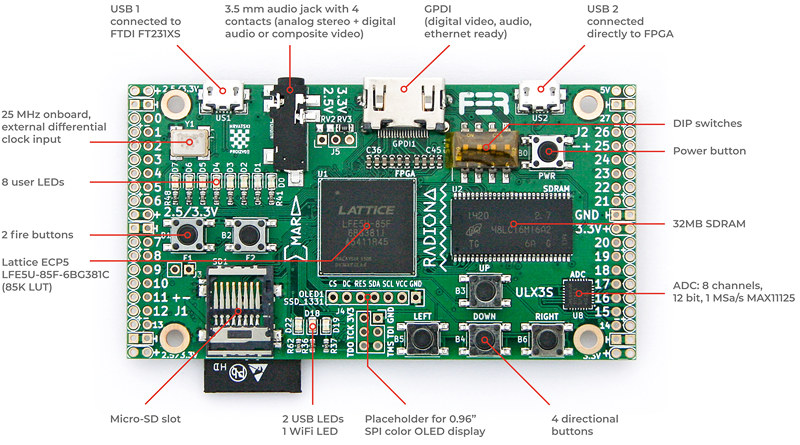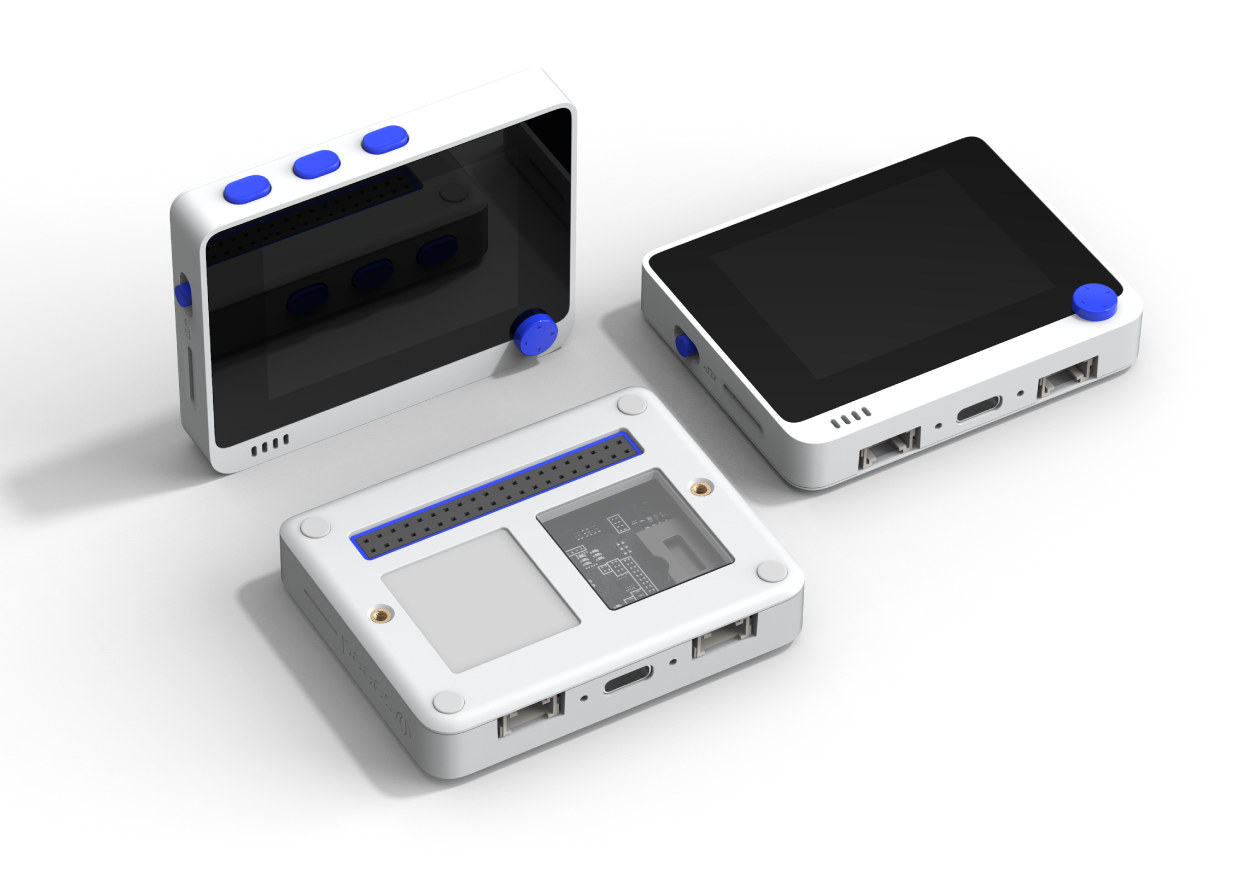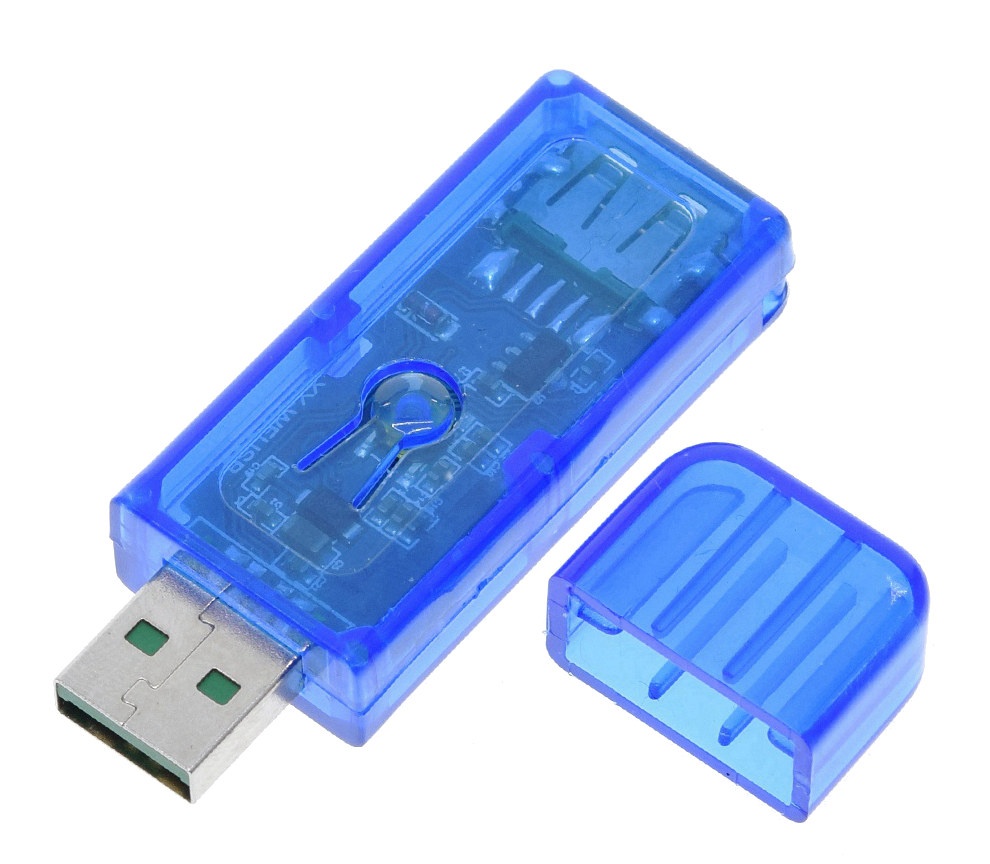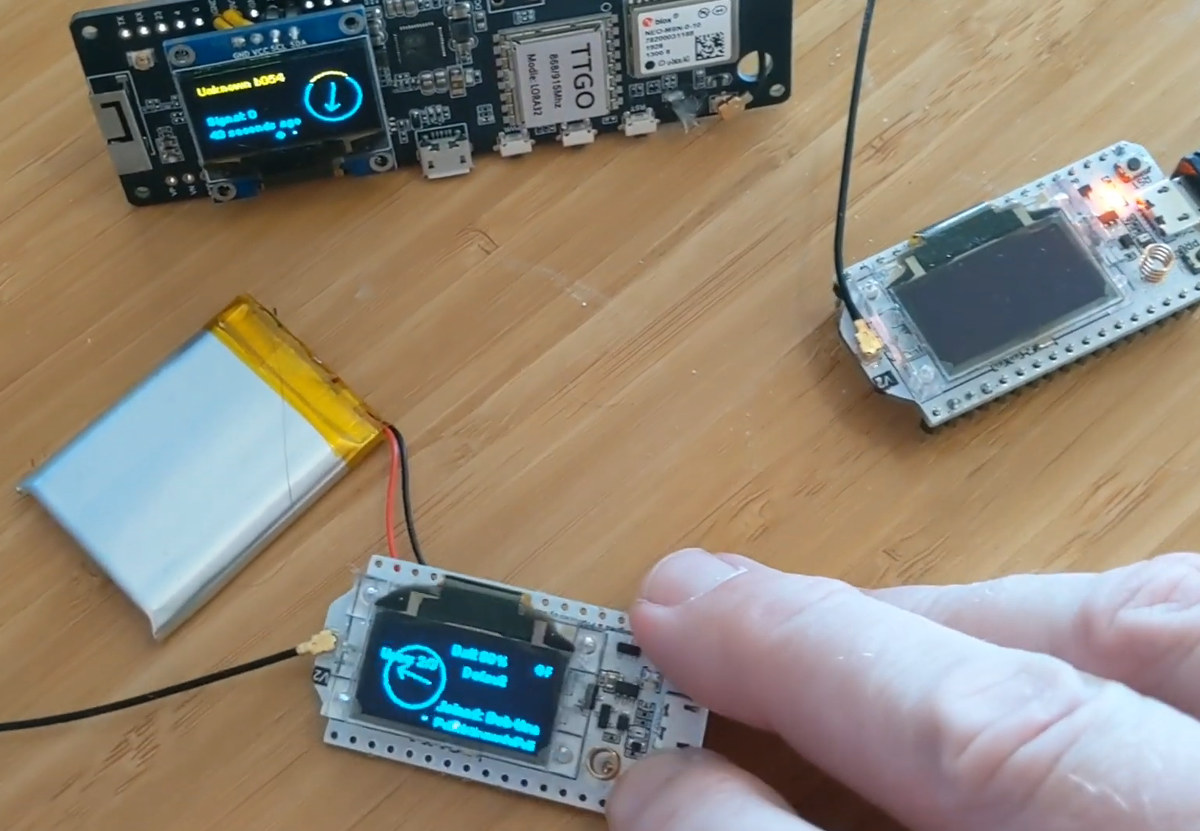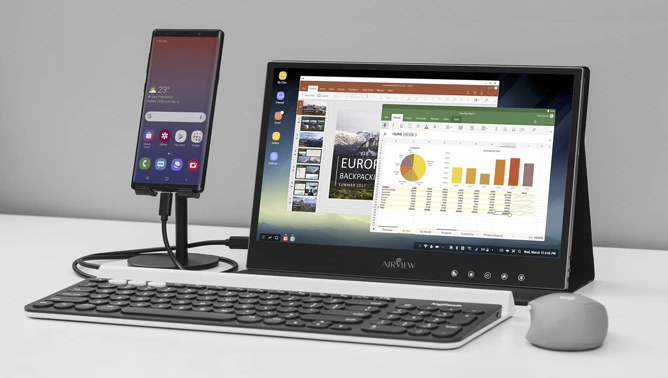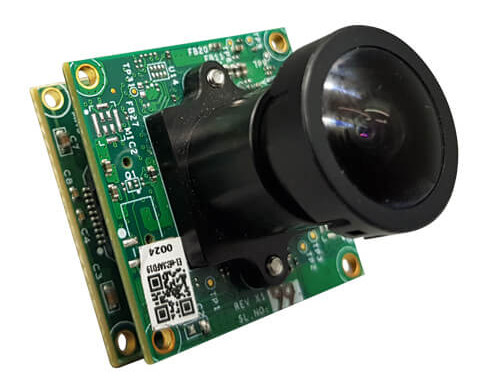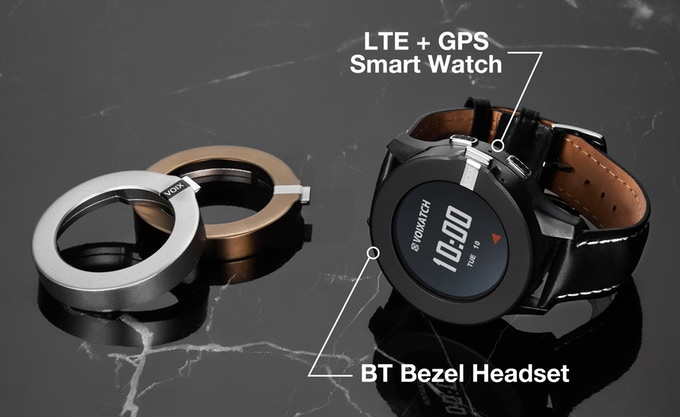Last summer, we wrote about Radiona ULX3S education board combining a Lattice Semi ECP5 FPGA with an Espressif Systems ESP32 WiFi & Bluetooth WiSoC. Designed for a digital logic course at the University of Zagreb, the board is open-source hardware with KiCAD hardware design files released on GitHub, and programmable with the Arduino IDE (FPGArduino) and ProjectTrellis open-source toolchain. At the time, there was only a version based on Lattice ECP5 85F with 84K LUT, but they’ve now made versions with cheaper variants of ECP5 FPGA and launched the board on Crowd Supply. Radiona ULX3S specifications: FPGA (one of the other) Lattice ECP5 LFE5U-85F-6BG381C with 84K LUT Lattice ECP5 LFE5U-45F-6BG381C with 44K LUT Lattice ECP5 LFE5U-12F-6BG381C with 12K LUT System Memory – 32MB SDRAM @ 166 MHz Storage – 4–16MB Quad-SPI Flash for FPGA config and user data storage; MicroSD slot Audio – 3.5 mm jack with 4 contacts (analog […]
Wio Terminal Features Microchip SAMD51 MCU, Dual-Band WiFI & Bluetooth WiFI, and 2.4″ LCD
Microchip SAM D5x Arm Cortex-M4 microcontrollers were introduced in 2017, and the next year we started to see Arduino or MicroPython compatible board brought to market including Adafruit Metro M4 or Tachyon boards. Seeed Studio has now introduced its own Arduino & MicroPython compatible SAMD51 platform with Wio Terminal also integrating an RTL8720DN dual-band WiFi 4 and Bluetooth 5.0 chip, and 2.4″ LCD display. There are also Grove connectors to add sensor modules, and a 40-pin header to use the device like a Raspberry Pi HAT. Wio Terminal features and specifications: MCU – Microchip SAMD51 (ATSAMD51P19) Arm Cortex-M4F microcontroller @ 120 MHz (can be overclocked to 200 MHz) with 192KB RAM, 512KB flash Storage – 4MB external SPI flash, MicroSD card slot up to 16GB Display – 2.4″ LCD screen with 320×240 resolution (ILI9341 driver) Audio – Microphone and buzzer Connectivity – Dual-band WiFi 4 802.11b/g/n and Bluetooth 5.0 via […]
K1 Smart Lock Box Secures Door Keys with Fingerprint, Mobile App, or Passcode (Crowdfunding)
We’ve previously reported about smart dock look solutions such as Xiaomi Sherlock M1 which allows you to provide access control without keys using your smartphone instead. Security concerns aside, one disadvantage of the Xiaomi smart lock is that it is only compatible with some doors, and can be complicated to install. YEEUU TECH has found a way that works with all doors with K1 smart lock box, a simple rugged box used to store physical keys, and that can be opened with a smartphone app, fingerprints, or a passcode. K1 smart lock box features and specifications: Bluetooth connectivity Permanent or temporary passcode unlock via backlit keypad; up to 100 passwords Permanent or temporary fingerprint unlock (optional); up to 50 fingerprints Remote control and instant share Time window support In-app management, access logs USB – 1x USB Type-C port for emergency power to open the box when batteries are dead Security […]
$5 Sinilink WiFI USB Power Switch Works with Tasmota Firmware, Supports up to 20V/5A
Late last year, ITEAD launched Sonoff Micro WiFi USB switch that allows you to turn on and off USB powered devices over WiFi using eWelink app for Android or iOS. It integrates with Amazon Alexas and Google Home, and does the job, but people who like to use the open-source Tasmota firmware will be disappointed to learn it’s not based on ESP8266 processor hence not compatible. Luckily, there’s another option: Sinilink WiFi USB switch (aka XY-WFUSB) based on ESP8266 WiFi SoC, and supporting up to 20V/5A according to the manufacturer. It is currently sold for under $5 including shipping on Aliexpress. Sinilink XY-WFUSB specifications: WiSoC – Espressif ESP8266 processor with 802.11b/g/n WiFi 4 USB Input – USB type-A female port supporting 3.5V to 20V up to 5A (100 Watts max) USB Output – USB type-A male port up to 100W Misc On/off button – Pressing 5 seconds also change the […]
Meshtastic Mesh Networking Project Combines ESP32, LoRa and GPS Radio
Meshtastic is a project using off-the-shelf, inexpensive ESP32-based hardware with GPS & LoRa connectivity to create mesh networks helping hikers. skiers, paragliders, or people exercising other outdoor activities communicate short messages such as their GPS location. This allows each member of a private mesh network to see the location and distance of all other members and read/or any text messages sent to a group chat. No phone is required unless you have an ESP32 LoRa board without GPS in which case it would get the GPS coordinates from your phone over Bluetooth. A phone is also needed to send a message. The project currently works on three different boards TTGO T-Beam, TTGO LORA32 and Heltec LoRa 32. The T-Beam is recommended as it sells for around $26 plus shipping and features a 18650 battery holder so you can source the battery easily locally. Just make sure to purchase the right […]
AirView Wireless Touchscreen Display Works with Phones, Laptops, Raspberry Pi, Etc. (Crowdfunding)
We’ve already written about several displays that take USB-C, HDMI or/and WiFi inputs to add a monitor to phones or computers including DUO add-on display and LAPSCREEN. AirView is another one of those and has launched on Kickstarter with a 13.3″ and 15.6″ Full HD versions featuring a touchscreen, built-in Miracast & AirPlay support, as well as HDMI and USB-C ports. It works with Android/iOS phones, traditional laptops & computers, SBC’s such as Raspberry Pi, and even game consoles. Two Airview models are available with the following hardware specifications: 15.6-inch model 1920×1080 resolution @ 60 Hz (4K model planned, but not available in KS) IPS display Multi-touch support Brightness – 250cd/m2 SRGB gamut – 98% Dimensions – 352 x 228 x 9.4 mm Weight – 1080 grams 13.3-inch model 1920×1080 resolution @ 60 Hz IPS display Multi-touch support Brightness – 300cd/m2 SRGB gamut – 100% Dimensions – 310 x 200 […]
e-Con Systems Launches MIPI CSI-2 Cameras for Google Coral Dev Board
Google Coral Development Board Camera Series e-Con Systems has announced a camera series that can be used with the Google Coral Development board. There are two models: e-CAM50 CUCRL is a 5.0 MP MIPI CSI-2 camera and e-CAM30 CUCRL is a 3.4 MP MIPI CSI-2 camera. Both Have Features In Common Both support a variety of resolutions and were developed for AI devices. The cameras are color and fixed focus and can be connected directly to the Coral Development Board through P1 and J15 camera connector. Background on Google Coral Development Board The Google Coral Development board was reported on extensively since its release in 2019. Two articles for the Coral Development Board and its most recent addons are the Google Coral Development Board announcement and the Coral Development Board’s latest mPCIe and M.2 cards. Jetson Nano and Rock960 SBC’s Cameras e-Con Systems previously made cameras for other SBC’s including […]
VOIXATCH Smartwatch Comes with a Detachable Bluetooth Headset (Crowdfunding)
As a Kickstarter project, VOIXATCH introduces the world’s first smartwatch device which puts essential features of all the devices we carry with us in one unit. This watch does everything that smartwatches do, plus it has a built-in Bluetooth headset. Other smartwatches can be used with Bluetooth headset, but VOIXATCH has a Bluetooth ring-look-like headset docked on it, and the headset can be detached anytime and used for phone calls or listening to the music. One can call it a headset smartwatch. Cool, huh? After Mobile World Congress 2019, where Voixatch demonstrated the watch, it is finally available for “purchase” on Kickstarter rewards starting at $179 and first batch delivery expected in June. VOIXATCH embodies LTE, GPS connectivity in an all-in-one truly wireless design that can be used with Google Voice. The watch can also be used as a cellular smartwatch with a bezel headset to make calls and stay […]


